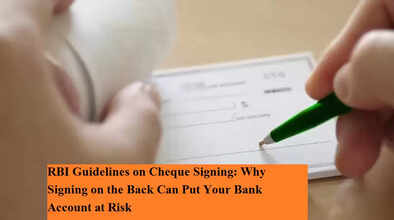RBI Guidelines on Cheque Signing: Why Signing on the Back Can Put Your Bank Account at Risk

Cheque Safety Rules 2025: Most of us use cheques for transactions, but very few people are aware of the correct way to sign them. According to the Reserve Bank of India (RBI), signing a cheque in the wrong place—especially on the back—can expose your account to serious risks, including fraud and unauthorized withdrawals. Let’s understand the essential rules you need to follow to avoid such costly mistakes.
Types of Cheques in India
There are mainly two types of cheques issued by banks:
-
Bearer Cheque: This works almost like cash. Whoever presents it at the bank counter can withdraw the money, regardless of whether their name is on it.
-
Order Cheque: This is payable only to the person whose name is written on the cheque. It is considered safer than a bearer cheque.
Do You Need to Sign on the Back of a Cheque?
-
Bearer Cheque: You do not need to sign on the back of a bearer cheque. Treat it like cash—if you mistakenly sign it, anyone who gets hold of the cheque can withdraw the money.
-
Order Cheque: If you want to transfer the cheque to another person, you must sign on the back. This process is called endorsement. However, you should only sign it if you truly intend to hand over the right to withdraw the amount.
The Danger of Wrong Signing
One of the biggest mistakes people make is signing the back of a bearer cheque out of habit. RBI warns that this can make it easier for fraudsters to misuse the cheque. In fact, surveys suggest that nearly 90% of people are unaware of this rule and end up making errors that can lead to financial loss.
The Correct Way to Sign
-
Always put your signature on the front side of the cheque in the designated box.
-
Only sign the back when transferring an order cheque to someone else.
-
If you are withdrawing money yourself, never sign the back of the cheque.
What to Do if Your Cheque Gets Lost
If your cheque book or an issued cheque goes missing, you should immediately inform your bank. The bank can then block the cheque to prevent fraudulent withdrawals and secure your account balance.
RBI’s Key Safety Guidelines
To keep your transactions safe, always follow these basic rules:
-
Write the payee’s name clearly—avoid leaving blank spaces.
-
Keep bearer cheques secure, as anyone can encash them.
-
Sign on the back only when transferring ownership of the cheque.
-
Always follow RBI’s official guidelines to protect your money.
Final Word
Cheques are still a widely used payment method in India, but a lack of awareness often leads to mistakes. Something as small as signing on the back of the wrong cheque can cost you your entire account balance. By understanding the difference between bearer and order cheques, and by following RBI’s safety guidelines, you can protect yourself from fraud and ensure smooth banking transactions.

